Proper Repairs and Consequences of Improper Repairs
 By Ray Heisey, PE, RRC
By Ray Heisey, PE, RRC
Senior Consultant
There are currently billions of square feet of all types of metal roofs in service as a primary water-resistant, weather barrier. Most of these roofs are performing as intended, but many are experiencing issues that result in roof leaks and possibly more severe problems than just a leak. If you are responsible for a problematic metal roof and are struggling with differing opinions on the cause of the problem and the best solutions, we’d like to offer some solutions or suggestions.
Steep slope and low slope metal roofs are made of sheets of metal (steel, aluminum, copper, zinc, etc.) that are formed to a prescribed shape. The sheets are then joined together to form a barrier to the elements. The predominant material used for metal roofs is steel. Steel is strong, even when the thickness is thin, which is the case with roof panel sheets. Steel roof panels can be as thin as 0.018” (26-gauge) and as thick as 0.030” (22-gauge). Steel is also hail resistant and puncture resistant. The physical properties do not change over time, and steel is not damaged by temperature changes or ultraviolet light. Steel sheets are impervious to leaks; however, the joint between sheets must be sealed to form a watertight and airtight gasket (barrier). When steel sheets are formed into roof panels, the side lap joints and end lap joints, use roof panel manufacturer prescribed and supplied sealants to form a gasket.
Steel sheets that make up a metal roof always have a coating to protect the steel from rusting (oxidation). A metallic finish such as galvalume (aluminum zinc alloy coating) is applied as a molten coating when the coil of steel is produced. A baked-on primer and paint finish can be applied over the metallic finish. Metallic or painted (prefinished) finishes can protect steel from deterioration for a minimum of 25 years and up to 50+ years. Protective metallic steel finishes are susceptible to attack from acid and base chemicals, as well as to galvanic corrosion. Galvanic corrosion attacks the less noble (cathode) metal (aluminum and zinc) when ions from a noble material (anode), such as copper or carbon black, are deposited in the presence of an electrolyte such as water.
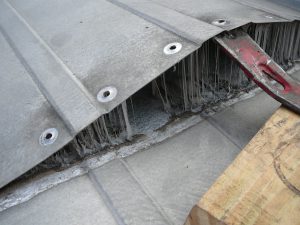
Butyl sealant webbing between roof panels.
Sealants are a critical part of weatherproofing metal roofs. Sealants form a gasket between the metal sheets, keep water and air from entering the roof system, and potentially into the building interior. Metal roof manufacturer supplied sealants are predominately butyl rubber tape sealant and pumpable butyl rubber sealant. Butyl rubber sealants do not cure, meaning a protective skin is not produced. Butyl rubber sealants must be placed in a concealed joint protected from ultraviolet light. Ultraviolet light will cause butyl sealants to lose flexibility, quickly oxidize, become brittle, and eventually crumble. Butyl sealants are designed to remain pliable and tacky throughout their service life. A butyl rubber sealant can allow movement in a joint and still provide a seal against water or air infiltration.
To properly seal a joint between two metal sheets, the sealant must be fully-adhered to both metal surfaces being joined. If the joint is pulled apart, the sealant should ‘web’, looking like a spider web as it stretches between the two sheets of steel. Properly installed butyl rubber sealant forms a gasket between the steel surfaces being joined together and repels the entry of water and air into the joint. Metal roof manufacturers also supply polyurethane sealants for use in sealing metal roofs, primarily at exterior gutters and roof penetrations. Polyurethane sealants form a skin and can be exposed to ultraviolet light without detrimental effect.
So, you have a leak in your metal roof. If the solid steel roof sheets cannot leak, where do you investigate to find the cause of the leak? Start with sheet metal lap joints where two or more sheets are joined together. This would include roof panel end laps, side laps, perimeter flashings, and roof penetration flashings. Look for poor fit-up of the steel sheets, which produce gaps and voids that are difficult to seal. A small wire probe inserted into a joint between two sheets of metal can help determine whether sealant is present, the type of sealant, and whether sealant is contiguous in the sheet metal joint.
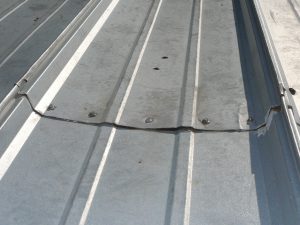 |
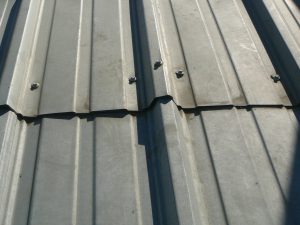 |
| Gap between roof panels at the end lap. | Gap between roof panels at the end lap. |
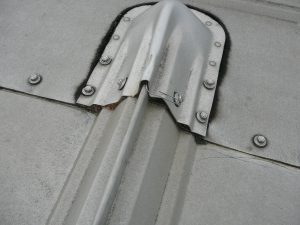 |
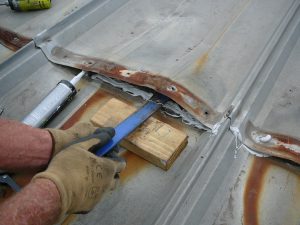 |
| Wire probe usage to check for sealant. | Resealing end lap with polyurethane sealant. |
The correct repair for an improperly sealed sheet metal joint is to remove the fasteners, open the joint, remove any dirt or failed sealant, reseal the joint with new sealant, and install new fasteners. Since the joint may not be able to be fully opened, such as with a standing seam metal roof, there is not enough room to install butyl tape sealant as was originally used. The sheet metal joint may have moisture and dirt present from water infiltration. The old butyl sealant may not be able to be fully removed from the surface of the steel sheets. A moisture curing, pumpable polyurethane sealant is an excellent replacement sealant. A polyurethane sealant is compatible with butyl rubber sealants and will tenaciously bond to even imperfect surfaces.
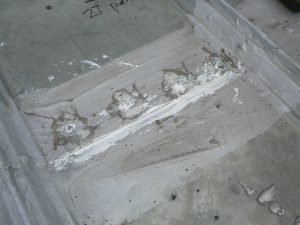
Resealed roof panel end lap joint.
Improper repairs are frequently attempted on metal roofs through the use of coatings, caulking, sealant, and single-ply membranes. In most cases, these repairs are topically applied and do not address the root cause of an improperly installed or failed sealant joint. Topical repairs rely on the adhesion of the coating, caulking, sealant, or membrane to the surface of the steel around the roof panel lap joint. Any previously applied repair materials must be fully removed and cleaned from the steel around the lap joint as recommended by the coating, caulking, sealant, or membrane manufacturer. Failure of the topical repair material to completely adhere to the steel roof panel surfaces could lead to moisture being trapped under the topical repair.
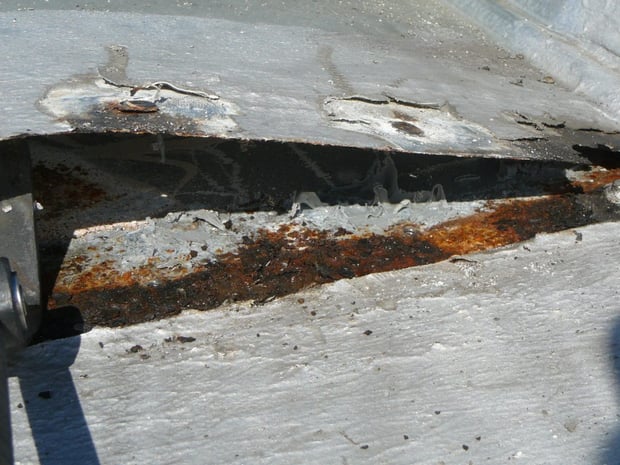
Trapped moisture caused accelerated corrosion.
Applying a topical repair material can trap existing moisture in the joint between the steel sheets or if the material is not properly adhered, allow outside moisture to be trapped under the repair material. In any case, moisture trapped on top of or between the steel sheets will lead to deterioration and require the replacement of the corroded components. In severe cases, the underlying structural members can also corrode, leading to extensive repairs or replacement.
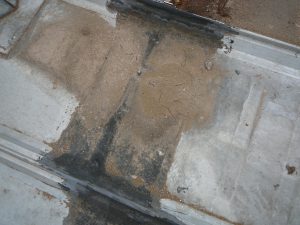
EPDM membrane repair over a roof panel end lap.
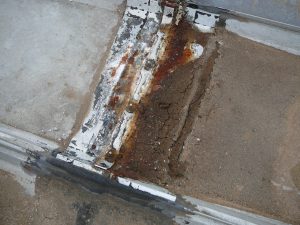
Removed EPDM membrane reveals severe corrosion.
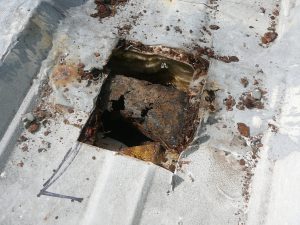
Severely corroded roof purlin under rusted roof panel.
The repair method of installing new sealant in the sheet metal joint is almost always less expensive and more effective than a topical repair. Do not let an improper repair be the cause of irreparable damage to your easily repaired metal roof. A metal roof should provide 25 to 40 years of service if regularly inspected and maintained. However, neglect or improper repairs can reduce the life of the roof or lead to premature replacement.
